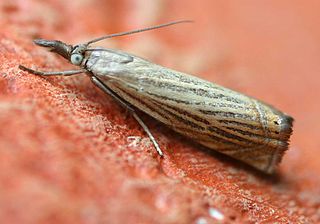This list contains species first discovered in Hong Kong, with the endemic species asterisked.

Pyraustinae is a large subfamily of the lepidopteran family Crambidae, the crambid snout moths. It currently includes about 1,280 species Most of them tropical but some found in temperate regions including both North America and Europe.

Agrotera is a genus of snout moths in the subfamily Spilomelinae of the family Crambidae. It is the type genus of the tribe Agroterini and currently comprises 28 species distributed in the Afrotropical, Palearctic, Indomalayan and Australasian realm.

Ancylolomia is a genus of moths of the family Crambidae described by Jacob Hübner in 1825.

Calamotropha is a genus of moths of the family Crambidae.

Chrysoteuchia is a genus of moths of the family Crambidae described by Jacob Hübner in 1825. Most are native to Asia.

Conogethes is a genus of moths in the subfamily Spilomelinae of the family Crambidae. The currently 17 recognized species are distributed in the Indomalayan and Australasian realm.

Udea is a genus of snout moths in the subfamily Spilomelinae of the family Crambidae. The genus was erected by Achille Guenée in 1845. The currently known 216 species are present on all continents except Antarctica. About 41 species are native to Hawaii.

Palpita is a genus of moths of the family Crambidae. Members of the moth genus Stemorrhages may be very similar in appearance.

Paracymoriza is a genus of moths of the family Crambidae.

Paratalanta is a genus of moths of the family Crambidae. Synonym is Microstega.

Tetracona is a genus of snout moths in the subfamily Spilomelinae of the family Crambidae. The genus was described by Edward Meyrick in 1884 with Aediodes amathealisWalker, 1859 as type species.

Palpita warrenalis is a moth of the family Crambidae described by Charles Swinhoe in 1894. It is found in south-east Asia, including China, India, Nepal, Indonesia, the Philippines, Vietnam, Papua New Guinea and Taiwan.
Pseudopagyda is a genus of moths in the family Crambidae. It contains only one species, Pseudopagyda homoculorum, which is found in Thailand and Yunnan (China). Males drink tears of various mammals, including humans.
Palpita indannulata is a moth in the family Crambidae. It was described by Hiroshi Inoue in 1996. It is found in Nepal, China (Guangdong), north-eastern India, Thailand, Indonesia, the Philippines, Papua New Guinea, and Australia.
Palpita kiminensis is a moth in the family Crambidae. It was described by Jagbir Singh Kirti and H. S. Rose in 1992. It is found in north-eastern India, China, Nepal, Myanmar, Thailand, Vietnam, Borneo, Sumatra and northern Australia.
Palpita curvispina is a moth in the family Crambidae. It was described by Zhang and Li in 2005. It is found in China.
Palpita inusitata is a moth in the family Crambidae. It was described by Arthur Gardiner Butler in 1879. It is found in Japan and China.
Palpita pajnii is a moth in the family Crambidae. It was described by Jagbir Singh Kirti and H. S. Rose in 1992. It is found in China, Taiwan, Vietnam, Thailand, Myanmar, Indonesia, the Philippines, India, Nepal, Australia (Queensland), Norfolk Island and Papua New Guinea.
Anania shanxiensis is a moth in the subfamily Pyraustinae of the family Crambidae. It was described by Zhaofu Yang and Jean-François Landry in 2019 as Anania sinensis, which turned out to be a junior secondary homonym of a previously described taxon, Anania lancealis sinensis(Munroe & Mutuura, 1968). The replacement name for A. sinensisYang & Landry, 2019 is Anania shanxiensisYang & Landry, 2019.












